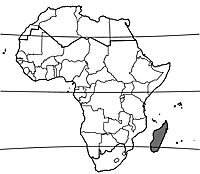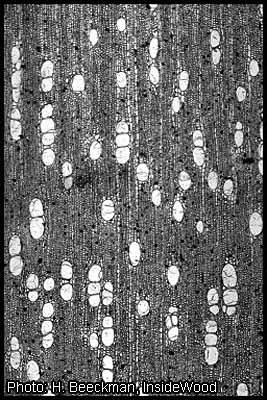Bridelia tulasneana (PROTA)
Introduction |
Bridelia tulasneana Baill.
- Protologue: Adansonia 2: 40 (1861).
- Family: Euphorbiaceae (APG: Phyllanthaceae)
Origin and geographic distribution
Bridelia tulasneana is endemic to Madagascar, where it is widely distributed in the eastern parts of the island.
Uses
The timber is locally used for house construction, boat building, coffins, weatherboards and shingles. It has been used for railway sleepers. It is suitable for joinery, interior trim, boxes, veneer, plywood and particle board. The local name ‘arina’ is given to a few tree species that yield superior charcoal, and apparently the wood is in demand for charcoal production.
Properties
The heartwood is beige marked with dark brown spots, and not well demarcated from the sapwood that is only slightly paler in colour. The wood becomes greyish upon exposure.
The wood is medium-weight, with a density of 550–580(–890) kg/m³ at 12% moisture content. It air dries slowly and it is difficult to avoid distortion during drying. The rates of shrinkage during drying are moderate, from green to oven dry 1.8–3.2% radial and 7.0–8.3% tangential. Once dry, the wood is moderately stable to unstable in service. At 12% moisture content, the modulus of rupture is 96–137 N/mm², modulus of elasticity 7750–11,200 N/mm², compression parallel to grain 46 N/mm², cleavage 18 N/mm and Chalais-Meudon side hardness 1.2–2.8(–5.0).
The wood saws and planes well, but it is brittle and moderately fissile. It holds nails and screws well, glues moderately well and paints easily. The heartwood is fairly durable, being moderately sensitive to fungal attack but quite resistant to termites and wood-boring beetles. The heartwood is resistant to impregnation with preservatives.
The lignan deoxypodophyllotoxin has been isolated from the bark. This compound has cytostatic properties, but cannot be used in chemotherapy because of serious side-effects.
Description
- Evergreen, monoecious small to medium-sized tree up to 20 m tall; bole usually straight, up to 100 cm in diameter but generally less, often with buttresses; bark surface with rather deep longitudinal fissures, pale brown to black; branches and twigs with c. 1 cm long spines; twigs covered with lenticels, red soft-hairy when young.
- Leaves alternate, distichous, simple and entire; stipules early falling; petiole 8–12 mm long; blade ovate or obovate, 8–14 cm × 2–9 cm, base rounded, apex short-acuminate, glabrous above, brown soft-hairy below, pinnately veined with 15–18 pairs of lateral veins.
- Inflorescence a small axillary fascicle, 10–20-flowered.
- Flowers unisexual, regular, 5-merous, glabrous; sepals fused into a short tube at the base; petals smaller than the sepals; male flowers with flat or concave disk, stamens with filaments fused in a column below, free and spreading above, ovary rudimentary; female flowers nearly sessile with superior, 2(–3)-celled ovary, styles 2, fused at base, 2-branched.
- Fruit a fleshy drupe c. 8 mm × 5 mm, dark purple when ripe, 1(–2)-seeded.
- Seeds ovoid, furrowed towards the tip, glabrous.
- Seedling with epigeal germination.
Other botanical information
Bridelia tulasneana flowers from October to January and fruits ripen around September.
Bridelia occurs in the Old World tropics, and comprises about 75 species. About 15 species occur in mainland tropical Africa and 2 species are endemic to the Indian Ocean islands.
Ecology
Bridelia tulasneana occurs in humid evergreen forest.
Genetic resources
Bridelia tulasneana is widespread and locally common in eastern Madagascar. However, the on-going deforestation may threaten its populations in the near future.
Prospects
Too little is known about Bridelia tulasneana to assess its prospects as a timber tree of commercial importance, but it deserves more research on silviculture and propagation.
Major references
- Capuron, R., 1966. Arina (Bridelia tulasneana Baillon - Euphorbiacées). Etude des essences forestières de Madagascar. Centre Technique Forestier Tropical, Antananarivo, Madagascar. 5 pp.
- Guéneau, P., Bedel, J. & Thiel, J., 1970–1975. Bois et essences malgaches. Centre Technique Forestier Tropical, Nogent-sur-Marne, France. 150 pp.
- Leandri, J., 1958. Euphorbiacées (Euphorbiaceae). Flore de Madagascar et des Comores (plantes vasculaires), famille 111. Firmin-Didot et cie., Paris, France. 209 pp.
- Parant, B., Chichignoud, M. & Rakotovao, G., 1985. Présentation graphique des caractères technologiques des principaux bois tropicaux. Tome 5. Bois de Madagascar. CIRAD, Montpellier, France et Département des Recherches forestières et piscicoles du FOFIFA, Antananarivo, Madagascar. 161 pp.
- Takahashi, A., 1978. Compilation of data on the mechanical properties of foreign woods (part 3) Africa. Shimane University, Matsue, Japan. 248 pp.
Other references
- Boiteau, P., Boiteau, M. & Allorge-Boiteau, L., 1999. Dictionnaire des noms malgaches de végétaux. 4 Volumes + Index des noms scientifiques avec leurs équivalents malgaches. Editions Alzieu, Grenoble, France.
- Brown, K.A., Ingram, J.C., Flynn, D.F.B., Razafindrazaka, R. & Jeannoda, V., 2009. Protected area safeguard tree and shrub communities from degradation and invasion: a case study in eastern Madagascar. Environmental Management 44: 136–148
- Cailliez, F. & Guéneau, P., 1972. Analyse en composantes principales des propriétés technologiques des bois Malgaches. Annales des Sciences Forestières 30: 215–266.
- Guéneau, D., 1967. Propriétés des bois étudiés en 1966. Centre Technique Forestier Tropical, Technologie No 21. Tananarive, Madagascar. 27 pp.
- Guéneau, P. & Guéneau, D., 1969. Propriétés physiques et mécaniques des bois malgaches. Cahiers scientifiques No 2, Centre Technique Forestier Tropical, Nogent-sur-Marne, France. 51 pp.
- Raymond, I., 1995. Approche phytoécologique sur l'évaluation qualitative et quantitative des utilisations villageoises des ressources naturelles en forêt dense humide sempervirente: cas du village d’Ambanizana, presqu’île de Masoala. Mémoire de diplôme d'études approfondies des sciences biologiques. Université d'Antananarivo, Madagascar. 87 pp.
- Sallenave, P., 1971. Propriétés physiques et mécaniques des bois tropicaux. Deuxième supplément. Centre Technique Forestier Tropical, Nogent-sur-Marne, France. 128 pp.
- Schatz, G.E., 2001. Generic tree flora of Madagascar. Royal Botanic Gardens, Kew, Richmond, United Kingdom. 477 pp.
- Williams, R.B., 2002. Isolation and structure elucidation of cytotoxic natural products from Suriname and Madagascar. MSc. Thesis Chemistry. Virginia Polytechnic Institute and State University, Blacksburgh, Virginia, USA. 101 pp.
- Winberg, E., 2009. Tropical forest resources and extraction– in Tsaratanana forest, Midongy, Madagascar. MSc. Thesis Biology. Göteborg University, Sweden. 71 pp.
Author(s)
- C.H. Bosch, PROTA Network Office Europe, Wageningen University, P.O. Box 341, 6700 AH Wageningen, Netherlands
- D. Louppe, CIRAD, Département Environnements et Sociétés, Cirad es-dir, Campus international de Baillarguet, TA C 105 / D (Bât. C, Bur. 113), 34398 Montpellier Cédex 5, France
Correct citation of this article
Bosch, C.H. & Louppe, D., 2012. Bridelia tulasneana Baill. [Internet] Record from PROTA4U. Lemmens, R.H.M.J., Louppe, D. & Oteng-Amoako, A.A. (Editors). PROTA (Plant Resources of Tropical Africa / Ressources végétales de l’Afrique tropicale), Wageningen, Netherlands. <http://www.prota4u.org/search.asp>.
Accessed 31 March 2025.
- See the Prota4U database.


